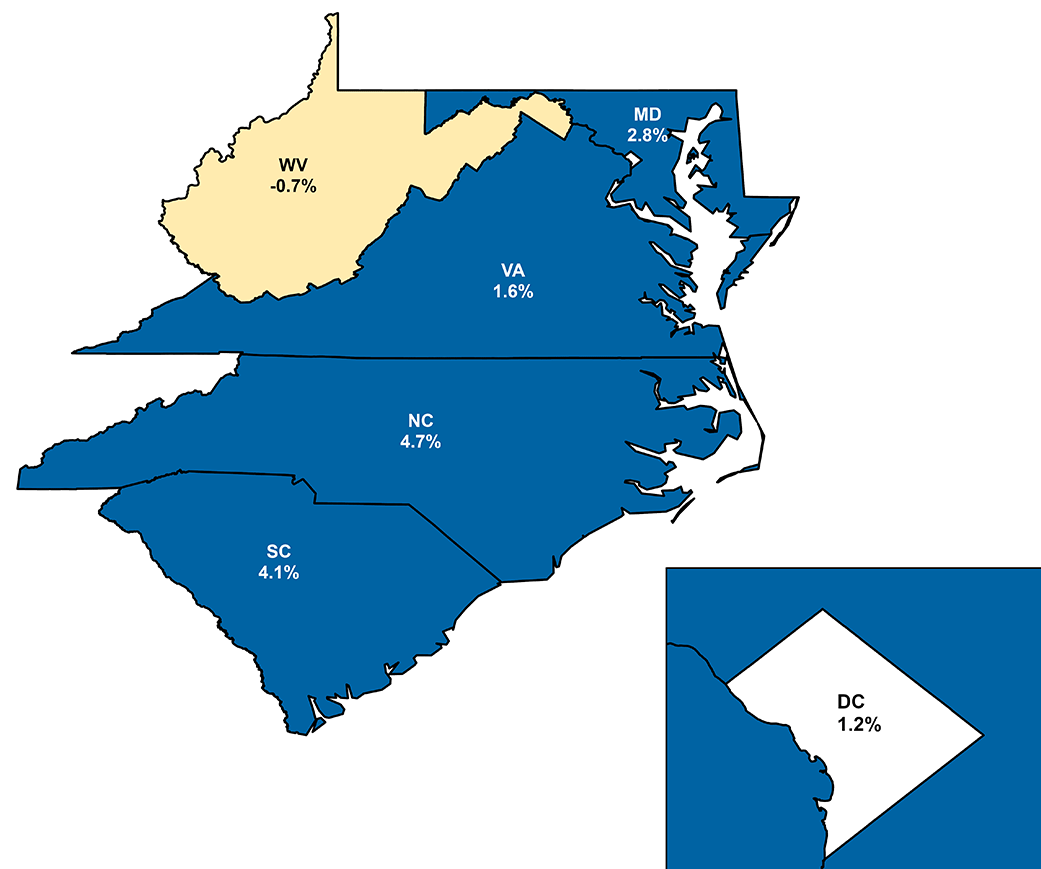Wraparound services like transportation assistance and child care foster student success. This post highlights how some community colleges are supporting student parents.
Previewing Fall 2024 College Enrollment
On Jan. 13, 2025, the National Student Clearinghouse Research Center (NSCRC) released a statement to report a methodological error leading to inaccuracies in the preliminary enrollment data published in the October 2024 "Stay Informed Report" referenced below. Click here to read our new, updated post on fall 2024 enrollment.
Introduction
The National Student Clearinghouse (NSC) released its first look at fall 2024 college undergraduate enrollment, and preliminary data shows an overall increase of 3 percent compared to fall 2023. In the Fifth District, North Carolina and South Carolina saw growth above the national average (4.7 percent and 4.1 percent, respectively) while Washington, D.C., Maryland, Virginia, and West Virginia saw growth below the average (ranging from a 0.7 percent decline in West Virginia to growth of 2.8 percent in Maryland).
Predominantly associate degree granting baccalaureate institutions (PABs) are traditionally two-year institutions that have expanded offerings to include at least one baccalaureate degree. Specifically, institutions that meet the following criteria based on Carnegie Basic Classifications:
- Confer at least 50 percent of awards at the associate level.
- Offer at least one baccalaureate degree program.
The PAB designation is to distinguish these institutions from their four-year institution designation in IPEDS. These institutions may be public, private nonprofit, or private for-profit, but the PAB sector data in this publication represents only public PABs. As of 2022-2023, there were only two public PABs in the Fifth District (Greenville Technical College in South Carolina and WVU Parkersburg in West Virginia).
Nationally, year-over-year fall enrollment growth was stronger at public two-year institutions and primarily associate degree granting baccalaureate (PAB) institutions, with enrollment increasing 4.7 percent and 5.2 percent, respectively. Enrollment at public four-year institutions increased 2.2 percent while enrollment at private nonprofit four-year institutions grew just 1.4 percent. However, enrollment is not increasing among all groups of students: There are concerning enrollment trends emerging for younger freshmen and students from lower-income neighborhoods.
For months, we have tracked the Free Application for Federal Student Aid (FAFSA) completions of students who completed high school in 2024, which have long been a good predictor of enrollment each fall. As we discussed here and here, there were numerous issues with the FAFSA in 2024 that raised serious concerns about fall enrollment across the country. In fact, as of Oct. 18, FAFSA completions for 2024 high school graduates were still down 8.8 percent compared to the previous year. This is the largest one-year decline in the FAFSA completions on record. Not surprisingly, data from the NSC show that college freshmen enrollment took a considerable hit this fall, falling 5 percent overall. Freshmen enrollment for students aged 18 fell 5.8 percent while 19- and 20-year-old freshmen enrollment declined by 8.6 percent compared to fall 2023. Enrollment of older freshmen, above age 20, increased, potentially indicating that the FAFSA delays were more of an issue to younger students.
The fall 2024 enrollment data released by the NSC shows other interesting enrollment patterns, including sharp increases in enrollment among high school students, via dual enrollment, and a shift in enrollment from degree programs to short-term certificate programs. (We plan to highlight some of these shifts in future posts.)
It is important to note from the start that these enrollment figures do not include any non-credit students, which at community colleges, make up a considerable percentage of the student population. In addition, only 51.9 percent of institutions representing 50.8 percent of college enrollment are included in these data, and colleges reported enrollment data as of Sept. 27. They should be viewed as a preliminary look into actual fall enrollment.
Freshmen Enrollment Declines
Freshmen enrollment has been relatively volatile since the tremendous 9.7 percent decline observed in fall 2020. Enrollment increased each year from 2021 to 2023, but not enough to cover the COVID-19-era losses. This year's 5 percent decline in freshmen enrollment is adding salt to the wounds for institutions that have struggled to rebound from the disruptions of the pandemic. While we do believe that the issues surrounding the FAFSA have impacted this group of freshmen, there are other dynamics as well, some of which are uncovered in the NSC data.
Moreover, it is important to remember that not all freshmen are 18 years old. The term freshmen refer to students who are enrolling for the first time, and while about 90 percent of them are between the ages of 18 and 20, some are much older. This year, enrollment has grown among those older students, while younger freshmen enrollment took a serious hit. The cumulative two-year growth of freshmen enrollment shows an increase of above 25 percent among freshmen age 21 and older, while younger freshmen enrollment has fallen considerably.
Different institutions cater to different age students. Eighteen-year-old freshmen make up a large percentage of freshmen at public and four-year institutions, while community colleges and PABs tend to have older student populations. Therefore, it is not surprising that freshmen enrollment declined more at four-year institutions than at their community college counterparts.
There are distinct differences in new freshmen enrollment by race. While all race categories saw declines this fall, White student enrollment fell much more severely, declining by 11.4 percent compared to last year.
This aligns with what we are hearing in our outreach. Many historically Black colleges and universities (HBCUs) saw strong enrollment growth this fall compared to average enrollment growth, and we have heard from HBCU leaders that they saw especially strong growth among new freshmen. In North Carolina, four of the five HBCUs in the University of North Carolina System saw total enrollment growth above the overall average of 2.2 percent, with North Carolina Central University seeing the highest at 7.7 percent growth. Some other colleges in the Fifth District, especially tuition-dependent private institutions that rely heavily on White, 18-year-old freshmen enrollment are experiencing declines.
Conclusion
Those following the FAFSA data are likely not surprised that colleges face challenges related to freshmen enrollment this fall. It is heartening, however, that overall enrollment rose, even in the face of a challenging year for financial aid, which a large percentage of U.S. college students rely on to pay for some of their education-related expenses. The FAFSA is delayed again this year, and instead of opening for applications on the typical Oct. 1, the planned opening date is Dec. 1.
We will first release data from the 2024 SCCO on Nov. 19 during a webinar. This will include non-credit data for the 2022-2023 academic year, and therefore gives a fuller picture of total community college enrollment.
Because the NSC data measure enrollment as of Sept. 27, total enrollment should continue to grow, especially at community colleges, which typically offer a large number of short-term classes that begin midway into the traditional semester. Additionally, since none of these data include students in non-credit programs, we know that many community college students are excluded. The Richmond Fed's Survey of Community College Outcomes (SCCO) includes these students, and we look forward to providing insight into the number of students who are excluded from typical enrollment figures.
Views expressed are those of the author(s) and do not necessarily reflect those of the Federal Reserve Bank of Richmond or the Federal Reserve System.
Receive an email notification when a new Community College Insights article posts:
Related Content
Community colleges can leverage a number of creative strategies and partnerships to provide long-term housing solutions for the unique student populations they serve.




